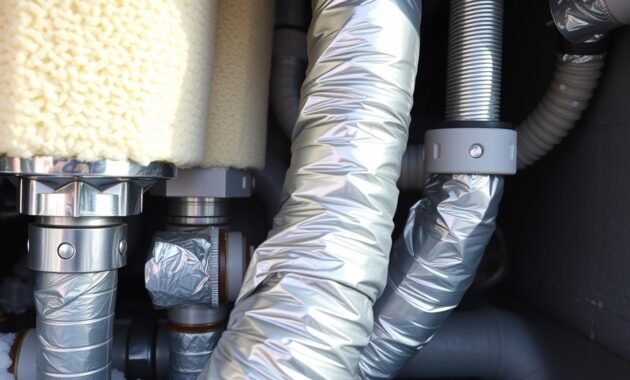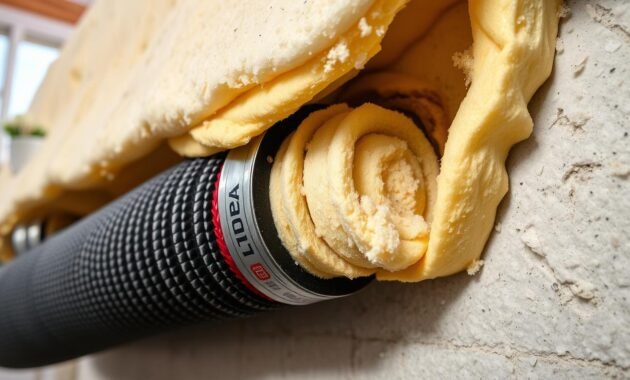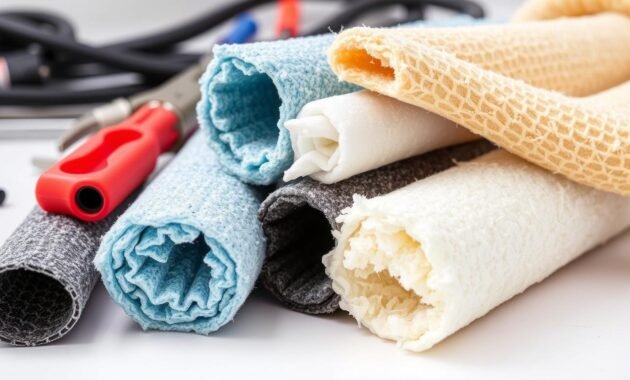Keeping your air conditioning system running well is key. One great way to do this is by insulating the refrigerant lines right. Without proper insulation, you might waste energy, have poor air quality, and damage your HVAC system early.
I’ll show you the top tips to keep your AC lines well-insulated. This will help you save on energy, stop condensation, and keep your air conditioner working great.

Key Takeaways
- Proper AC refrigerant line insulation can reduce energy bills by up to 30%.
- Insulating AC lines is vital for better HVAC system efficiency and performance.
- Insulation stops heat gain or loss in refrigerants, improving air quality by reducing water leaks.
- Polyethylene foam is a top choice for AC line insulation because it’s easy to install and affordable.
- Regular maintenance checks and seasonal evaluations are key to keeping insulation effective and saving energy.
Read also: How to Install Faced Insulation
Understanding AC Refrigerant Line Basics and Their Importance
AC systems use refrigerant lines to move coolant between units. The suction line, the larger one, carries cool refrigerant back to the compressor. Insulating these lines well is key for good air conditioning and saving energy.
Types of Refrigerant Lines in HVAC Systems
AC lines are made from copper, aluminum, and coated steel. Copper is top choice for its strength, heat transfer, and resistance to corrosion. But, copper’s cost might make homeowners choose other materials, like aluminum or coated steel, which could affect system performance.
Role in Air Conditioning Performance
Insulated ac lines keep refrigerant at the right temperature. This is vital for the system’s efficiency. Leaks in these lines can lead to higher energy use and wear on parts. Tools like refrigerant leak detectors help find these leaks early.
Impact on Energy Efficiency
The size of ac lines, including diameter and thickness, is important for efficiency. The right size and installation prevent system failure. Long lines can cause pressure drops and higher energy use, so shorter lines are better.
It’s important to focus on ac line sets, including installation, insulation, sizing, and upkeep. This ensures energy efficiency and a long system life.
Essential Tools and Materials for AC Line Insulation
Insulating your AC refrigerant lines needs the right tools and materials. This ensures a successful and lasting installation. Let’s look at what you’ll need to do the job well.
A good measuring tape is essential. It helps you measure your copper pipes accurately. This is key to picking the right insulation size. You’ll also need a sharp utility knife or scissors to cut the insulation material to fit.
Cleaning the pipes before insulation is important. Use a mild detergent and a soft brush to remove dirt and debris. This ensures the insulation sticks well.
- Measuring tape
- Utility knife or scissors
- Mild detergent and soft brush
For insulation materials, you can choose between foam and elastomeric insulation. Foam insulation, like polyethylene or polyurethane, is popular for its thermal efficiency and easy installation. Elastomeric insulation is better for outdoor use because it resists moisture well and lasts long.
Read also: Basement Ceiling Insulation Cover
| Insulation Type | Thermal Efficiency | Moisture Resistance | Durability |
|---|---|---|---|
| Foam Pipe Insulation | High | Moderate | Good |
| Elastomeric Insulation | High | Excellent | Excellent |
Choose insulation that fits your copper pipes well for best performance and energy savings. With the right tools and materials, your AC line insulation project will be a success.
AC Refrigerant Line Insulation: Step-by-Step Process
Insulating your AC refrigerant lines is key to keeping your system running well and saving energy. By following a clear process, you can make sure your air conditioning works its best. This helps prevent heat gain and cuts down on energy costs. Let’s explore how to insulate your AC refrigerant lines step by step.
Preparation and Safety Measures
First, make sure you’re safe before starting. Turn off the AC unit and unplug it to avoid electrical dangers. Then, remove any old insulation to clean the refrigerant lines.
Measuring and Cutting Techniques
Getting the right measurements is critical for a good fit. Use a tape measure to find the length and diameter of the lines. Remember to account for bends or special fittings. After measuring, cut the insulation to fit perfectly around the pipes.
Application Methods
Now, it’s time to put the insulation on. Wrap it around the lines carefully, making sure it fits well. Overlap seams and press down to block heat. Use tape or clamps to hold it in place, but don’t squish the insulation.
By following these steps, you can insulate your AC refrigerant lines effectively. This will improve your system’s performance, lower energy use, and make your home more comfortable.

Common Issues and Troubleshooting Noisy Refrigerant Lines
Keeping your air conditioning system quiet and efficient is key for many homeowners. The refrigerant lines, which carry the cooling agent, can sometimes be noisy. This is often due to improper installation or vibration. Luckily, there are ways to fix this and make your ac refrigerant line insulation work better.
Loose clamps or supports on the refrigerant lines are a common cause of noise. Tightening these and using better straps can help. Adding weight to the lines at the outdoor unit also helps reduce vibrations. Loosening the supports slightly can further reduce noise.
Lennox air conditioning units often have metal sleeves in the foot grommets. Removing these can greatly reduce noise. This simple change can make a big difference in your ac refrigerant line insulation’s sound levels.
Fixing noisy refrigerant lines is vital for a quiet and efficient air conditioning system. By ensuring proper installation and securing the lines, you can cut down on noise. This makes your indoor space more peaceful. Fixing these issues early can also save you from more expensive repairs later.
Choosing the Right Insulation Material for Your AC Lines
Choosing the right insulation for your AC lines is key. You need to think about temperature resistance, durability, and your AC system’s needs. Foam insulation and closed-cell elastomeric insulation are two top picks.
Read also: How to Install Faced Insulation
Foam vs. Elastomeric Insulation
Foam insulation is popular for its easy installation and low cost. But, closed-cell elastomeric insulation is better for AC lines. It can handle temperatures from -40°F to 257°F, working well in both heat and cold.
Temperature Considerations
The temperature of your AC lines can change a lot. The suction line is around 40°F, while the liquid line can get up to 110°F. It’s important to pick insulation that can handle these temperatures to keep your AC running well.
Durability Factors
Closed-cell elastomeric insulation, like EPDM from Aeroflex USA, lasts a long time. It also resists UV damage, keeping your AC lines insulated for years. This is great for areas with harsh weather.
When picking insulation for your AC lines, think about temperature, durability, and your system’s needs. Closed-cell elastomeric insulation, like Aeroflex’s options, is the best for ac pipe insulation and refrigerant line insulation tape.

Professional Tips for Proper Line Support and Mounting
As an HVAC pro, I’ve found that the right support and mounting are key. They ensure your ac coolant line insulation, freon line insulation, and ac condenser line insulation work well. Here are some tips to get your ac line insulation set up right:
- Don’t strap refrigerant lines too tight to buildings. It can cause vibrations and problems later.
- Use strap-type materials for support instead. They’re better than rigid metal clamps.
- When lines go through walls, leave a small gap. Seal it with silicone for expansion and contraction.
- Keep a two-foot gap between your outdoor unit and plants or buildings. It helps with airflow and prevents issues.
By following these tips, you can make sure your ac coolant line insulation, freon line insulation, ac condenser line insulation, and ac line insulation system works great. It will run efficiently and effectively for many years.
Energy-Saving Benefits of Well-Insulated AC Lines
Keeping your air conditioning system efficient is key to a comfortable home and lower bills. One important step is insulating your AC refrigerant lines well. High-quality insulation can save you a lot of energy and money over time.
Cost Reduction Analysis
Insulated AC lines can cut energy use by up to 15%. This means big savings on your bills, mainly when it’s hottest. Insulation keeps the refrigerant cool and stops heat from getting in, making your AC work better with less energy.
Environmental Impact
Insulating your AC lines also helps the planet. It cuts down on greenhouse gases and your carbon footprint. Plus, it stops water leaks and mold, improving your indoor air. This makes your HVAC system more efficient, saving you money and helping the environment.
Insulating your AC lines is a smart move to save energy, prevent condensation, and keep your air conditioner running smoothly. It’s a small investment for big benefits: lower bills and a healthier home.
Maintenance and Inspection Guidelines
Keeping your air conditioning system running well is key. Proper insulation of the refrigerant lines is a big part of this. As an HVAC fan, I’ve found that regular checks and maintenance are vital. They help your system work better and save you money on energy.
For your ac refrigerant line insulation to stay good, do monthly checks. Look for damage, moisture, or if it’s cooling less well. Do a deeper check seasonally, as damage can change with the seasons.
- Check for cracks, tears, or deterioration in the insulation material.
- Ensure the insulation is securely in place and not peeling off the lines.
- Inspect for any signs of moisture or condensation buildup, which can indicate insulation failure.
- Monitor the system’s energy efficiency, as a decrease in performance could signal a problem with the insulation.
If you see damage or a drop in energy use, it’s time for new insulation. Use the right insulation, like closed-cell foam or rubber, to keep your system running right. This prevents problems like sweating or freezing lines.
Regular maintenance and checks of your ac refrigerant line insulation are important. They keep your HVAC system running smoothly, save you money, and make your equipment last longer. By doing these tasks, you can keep your home cool and comfy all year.
Seasonal Care Tips for AC Line Insulation
As the seasons change, it’s key to keep your window air conditioner’s refrigerant lines insulated. This ensures your AC works well and saves energy. A few simple steps can make your home comfy and lower your energy bills.
Summer Preparation
Before summer hits, check and service your AC. Start by cleaning the outdoor condenser coils. Remove any debris to ensure good airflow and prevent overheating. Also, check the refrigerant line insulation for damage and fix it if needed.
Winter Protection Measures
In winter, protect your outdoor AC unit and the insulation for ac refrigerant line from the cold. Use an AC cover to keep snow and ice off. Make sure the ac pipe insulation is thick enough to keep heat in and efficiency up.
By following these tips, you can make your air conditioning system last longer. It will keep your home cool and warm all year.
Conclusion
In conclusion, ac refrigerant line insulation is key for your air conditioning system’s efficiency. Knowing about refrigerant lines and insulation is important. It helps your HVAC system work better, saving energy and cutting down on bills.
Choosing the right insulation material and following installation and maintenance tips is vital. The insulation thickness is critical for the best results. So, pick the right insulation for your needs.
By focusing on proper refrigerant line insulation, you get better comfort and energy savings. This makes your HVAC system more eco-friendly. Use these tips to manage your cooling costs and keep your place comfy all year.